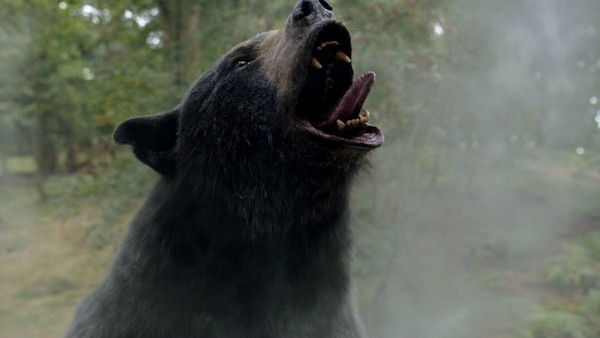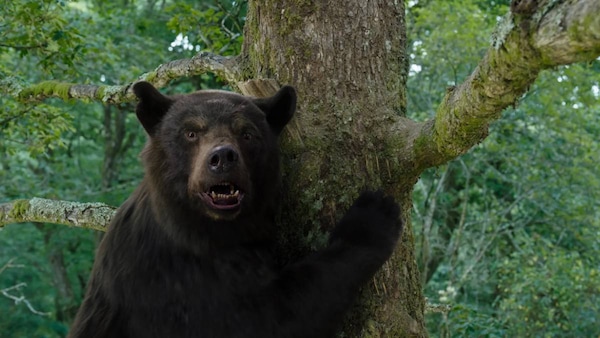Cocaine Bear Is Addictive, But Falls Short Of Horror-Comedy Gold
This is #CineFile, where our critic Rahul Desai goes beyond the obvious takes, to dissect movies and shows that are in the news. Today: Cocaine Bear.

Last Updated: 01.12 PM, Feb 26, 2023
IT HAD US at “Cocaine Bear”. I suspect this black (bear) comedy might not have been such a viral sensation if it were concocted out of thin air. Then it’d be just another fictional creature feature. But much of the film’s novelty is that it is (very, very loosely) based on true events. It’s one of those Ripley’s Believe It Or Not tales that simply can’t be made up. It’s also one of those unfortunate tragedies that is socially acceptable to snort-laugh at. In 1985, a 175-pound American black bear was found dead in the forests of Northern Georgia. Apparently, it had overdosed on cocaine that was dropped into the wilderness during a botched drug shipment. Its stomach was “filled to the brim” with the powder.
Its death would be sad if it weren’t so stupid. Which is why Elizabeth Banks’ film reimagines this event as an irreverent and sheepishly feminist gorefest, where the over-stimulated beast goes on a coke-fuelled killing rampage. She tears people to shreds to ‘sustain’ her newfound addiction. It’s a bit like (a parody of) Jurassic Park in terms of how Cocaine Bear views the unhinged animal — as a murderous manifestation of human greed. The bear may have died a meme-destined victim in the real world, but Banks gleefully turns her into an instrument of chaos, deriving great pleasure out of an otherwise-peaceful predator’s sudden appetite for blood and violence. I mean the bear went on to be known as Pablo Esco-bear — the only crime is how long we’ve had to wait for the inevitable B-movie about it to surface.
The twisted humour is ready-made; the title itself is more entertaining than entire movies. Throw in some absurd chases and spoofy limb-strewn attacks, some quasi-slasher-flick tension and deadpan sadism — and it’s almost impossible to fluff those lines, both literally and otherwise. A set-piece featuring the bear hunting down a speeding ambulance and dismembering the panicked humans inside is an instant classic. As is the moment she collapses and passes out on a terrified man, which is also when we find out it’s a female bear because “her vagina is near my ear”. The image of a desperate bear snorting powder off mutilated body parts might never get old either.
Yet, for all its inspired cheek, Cocaine Bear falls short of horror-comedy gold. It suffers from what we call a ‘problem of plenty’ — the equivalent of a talented batsman in a cricket match having so much time on their hands that shot-selection becomes an issue. The possibilities-are-endless syndrome afflicts the film that, at points, succumbs to its own shapeless excitement. It’s fun when the unpredictable bear appears on screen to wreak havoc, but for some reason, there’s too much story in between. The film feels over-staged in that sense; there are too many characters and mini-narratives colliding in the forest. I could have watched hours of the bear making a mockery of her fleshy victims, but maybe the movie doesn’t seem to trust her trip enough.
The purpose is to go to town with a crowded meeting of genres — a spunky mother/nurse looking for her daughter; two doomed hikers; drug smugglers searching for the remaining bags; a kingpin; a park ranger crushing on a colleague; three small-time crooks; a veteran cop; a cave and a waterfall-laden climax — but what this really does is dilute the core Cocaine-bear-ness of the film. The setup is too long, and a little less density might have allowed the audacity of the central theme to shine through. I kept trying to cringe and laugh and shudder more, but the humans and their weirdly straitlaced conflicts kept testing my patience. Banks and writer Jimmy Warden invest too much in the half-witted emotions of each track, almost like they’re compensating for the blatant coolness of the concept.

In the process, the idea of a nutty coke-addicted bear becomes more seductive than the actual film. My expectations became a deceptive part of my viewing experience. It sways wildly between a self-serious adventure and a self-aware trollfest — it’s hard to care for the stretched fates of multiple protagonists when all we need is our next fix of the bear. The film refuses to quit while it’s ahead, instead fashioning a convoluted landscape to accommodate the wanton wildness of the bear. It’s an unnecessary design, a version of the weak by-the-way plotting in a dumb actioner. I never thought I’d miss a crazy bear with addiction issues, but that’s where we’re at.
I’d like to believe that the excessive presence of humans is deliberate, perhaps a way to suggest that not even distinct shock value can give an animal a leading role in its own story. But that’s a bit too far-fetched (imagine using this adjective to blame the ‘sanity’ of a story), given that the bear is by far the best performer in the film. She conveys volumes with her nose alone, while most of the human actors (including the late Ray Liotta) look and move like future meals. The climax belongs to a separate world altogether, and the genre-fluidity turns the film into the most formulaic version of itself. It had us at “Cocaine Bear”. It didn’t need to go and behave like a movie.
